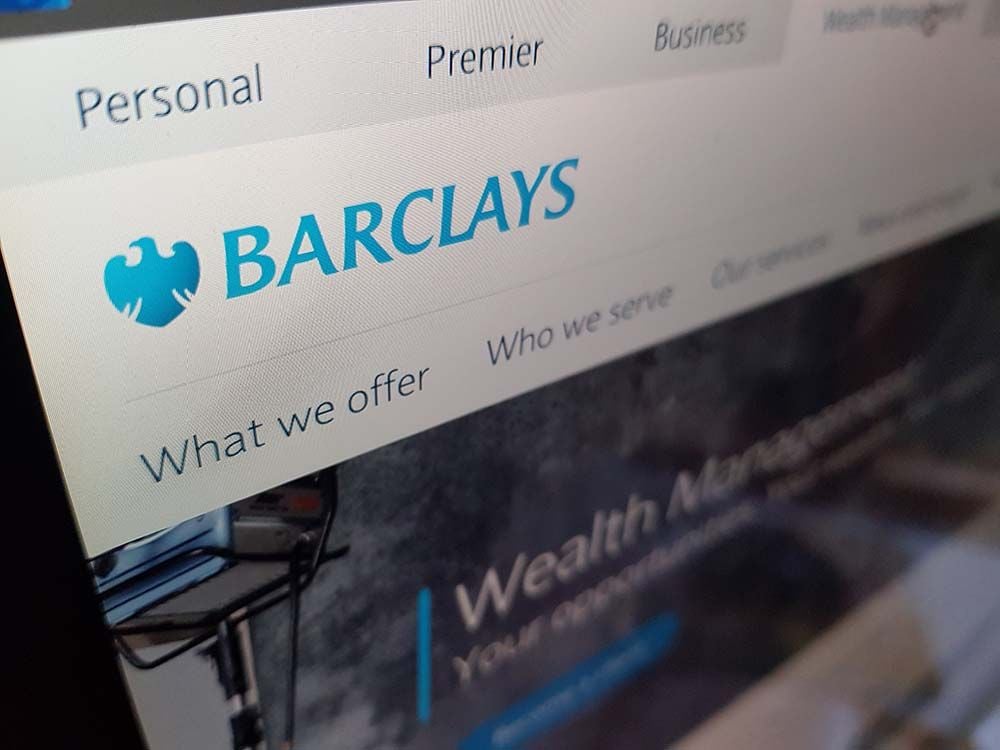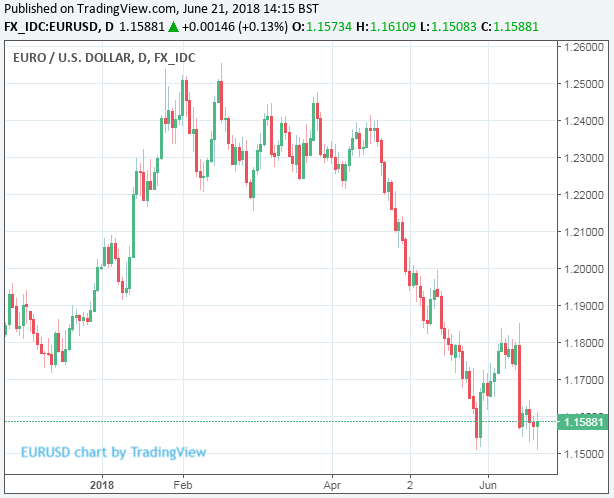Euro-to-Dollar Rate Forecasts Downgraded at Barclays as Credit Suisse Strategists Stay "Short" the Single Currency
- Written by: James Skinner
-
-Euro woes are not over yet say strategists at Barclays, Credit Suisse.
-Trade war, EU politics, slow growth and divergent interest rates to weigh.
-"Hold onto shorts" says Credit Suisse as Barclays cuts forecasts by 10%.

© Pound Sterling Live
The Euro-to-Dollar rate fell to a new 2018 low Thursday as the US Dollar remained on the front foot during the London session, although strategists at some of Europe's largest banks are increasingly suggesting the exchange could have much further fall during the months ahead.
Strategists at Barclays cut their Euro-to-Dollar forecasts by 10% on Thursday just after the FX team at Credit Suisse advocated that clients of the bank keep betting on a further fall in the exchange rate this summer.
Forecast downgrades and increasingly bearish sentiment toward the single currency come after weeks of political upheaval on the continent and hard on the heels of the June monetary policy statement from the European Central Bank, which saw the ECB crush market hopes of an initial Eurozone interest interest rate rise next June.
The EUR/USD rate was quoted 0.29% lower at 1.1544 Thursday and is now down 3.7% for the 2018 year-to-date. Since late April it has more than reversed what was previously a 4% gain for the current year.
This was a move that many attribute to divergence between US and Eurozone economies, a resurgent US Dollar and market unease over a eurosceptic government in Italy and an increasingly fragile political situation in Germany.
"Three forces will likely support further EURUSD downside through year-end, in our view," says Nikolaos Sgouropoulos, an FX strategist at Barclays.

Above: Euro-to-Dollar rate shown at daily intervals.
Sgouropoulos says continued divergence between US and Eurozone economies will be a key driver behind the Euro-to-Dollar rate in the year ahead because it is the source of Euro-US monetary policy divergence, which is Barclays' second reason for suggesting the Euro-to-Dollar rate will fall further.
Faster US growth would vindicate the Federal Reserve for hinting in June that it could raise rates four times for 2018, rather than on the three occasions markets had anticipated. This comes alongside a deteriorating outlook for Eurozone interest rates, with the ECB suggesting this month that it will not contemplate a rate rise until late in 2019.
Political risk is the third and final force likely to drive the exchange rate lower. Italy's government is due to submit its maiden budget, which is expected to place the country further on the wrong side of EU fiscal rules, to the European Commission for approval in October. Fears are that it will spark a diplomatic row and more anti-Euro sentiment in the Mediterranean nation.
Meanwhile, Chancellor Angela Merkel's already-fragile coalition government is clinging to the ropes in Germany after renewed disagreement between coalition partners over migration policy.
A growing scandal that has seen the Chancellor accused of turning a blind eye to corrupt practices at the government's refugee agency is also stoking unease. It is alleged that a German official has granted asylum to ineligible applicants in exchange for bribes.
Both of these plot lines have the power to prompt renewed concerns about political stability in the bloc and to place the Euro under increased pressure during the months ahead.
"We see EURUSD bottoming at around 1.12 by Q4 18 with only a modest retracement towards 1.14 by Q2 19, at which point we expect Fed rate hikes to be better priced," says Sgouropoulos.
Until Thursday, Barclays had forecast the Euro-to-Dollar rate would finish the year at 1.22.
Above: Euro-to-Dollar rate shown at weekly intervals.
The now-downbeat outlook for the common currency chimes with the sentiments of analysts at Credit Suisse, another major European investment bank, who advocated this week that clients keep betting against the Euro.
"We have been EURUSD bears from above 1.18, but we were minded to take profits just ahead of the 2018 lows near 1.1510. But now, if either of these topics blow up further ahead of the June 28-29 European summit, the level could break as in principle the market would have new negatives to justify that idea," writes Shahab Jalinoos, head of FX strategy at Credit Suisse. "Together with perceived EUR vulnerability to trade wars, we see value in holding onto our EURUSD and EURJPY (from above 130) shorts for now."
Jalinoos identifies the same political concerns as Sgouropoulos as grounds for maintaining a bearish outlook on the common currency, although the Credit Suisse team also say that the so called trade war between the US and China will be positive for the greenback and negative for the Euro-to-Dollar rate.
Analysts are bitterly divided over whether a trade war would be good or bad for the Dollar although Jalinoos concludes in his latest briefing that if there are to be any adverse consequences for the greenback, they will only become clear and relevant for markets over the longer term.
Meanwhile US tariffs open the door to a possible fall in American imports of goods from the rest of the world during the short-term, which means less Dollars being dumped on the market. Tariffs could also encourage higher domestic business investment to facilitate companies producing more goods at home rather than importing them from overseas.
"The US appears willing to take on a number of different countries at the same time, driven by President Trump's view that only the US would be a clear and easy winner of a trade war. As such, ramped up tensions with China also raise fears of similar intransigence when dealing with other issues such as EU or Nafta negotiations," the strategist writes.
Above: Euro-to-Dollar rate shown at monthly intervals.
President Donald Trump instructed US trade representatives on Monday to begin preparing a 10% tariff on imports of more than $200 billion in Chinese goods, which has already drawn a threat of retaliation from China's Ministry of Commerce.
That followed last Friday's decision to push ahead with $50 billion of tariffs on Chinese technology products, in the name of combating alleged unfair trade practices, despite President Trump having said in May that China has agreed to substantially increase imports of US agricultural goods in order to reduce the bilateral trade deficit.
Fears are that the tit-for-tat tariff fight will dent economic growth in the US and China, which could have spillover effects for economies elsewhere in the world. The Trump administration is also holding the North American Free Trade Agreement countries over a barrel and has threatened the European Union with tariffs on automotive imports.
Advertisement
Get up to 5% more foreign exchange by using a specialist provider to get closer to the real market rate and avoid the gaping spreads charged by your bank when providing currency. Learn more here
